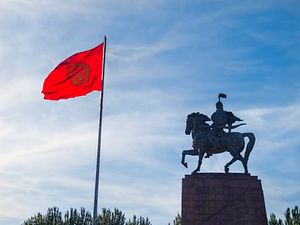Local elections in Kyrgyzstan are officially slated for April 11. After the hubbub of parliamentary elections in October and Sadyr Japarov’s election in January, campaigns for village councils might seem like a secondary concern – but these elections are worth careful attention, as they are a laboratory for broader political dynamics.
More than 8,000 deputies are up for election in 448 municipalities, including the cities of Bishkek and Osh. This is an unusually large stack of local races, partially because it includes those that were cancelled last spring due to the pandemic. Winners will represent their local constituency for four years, and city councils are responsible for choosing mayors, who report to the president.
As of February 25, 25 parties have announced their intention to run candidates for Bishkek’s City Council and 10 have done so in Osh. Fewer parties have started the registration process in Kyrgyzstan’s smaller cities where they have until March 1 to get in the race, while parties can figure out their strategy for village-level races until March 11. Smaller or regionally-concentrated parties need to be prudent about stretching their funds, given that local council elections still have a (prohibitively high) 7 percent threshold for securing seats. For larger parties vying for national power, however, it makes sense to campaign across the country; as political analyst Azim Azimov explained, these elections are a test of political parties’ viability.
Kyrgyzstan’s party landscape has changed significantly in the last year: the Social Democratic Party of Kyrgyzstan, to which both former presidents Sooronbay Jeenbekov and Almazbek Atambayev belonged, fractured and failed to run candidates for parliament or president; two new pro-government parties, Birimdik and Mekenim Kyrgyzstan, dominated the October 2020 elections that sparked a political crisis. Prominent politicians who had jumped from the Ata-Jurt party to the Mekenchil party managed to lodge themselves into some of the most powerful government positions, including President Sadyr Japarov and head of National Security Council Kamchybek Tashiev. In short, party politics have been a doozy, and the ride isn’t over yet.
Given Mekenchil’s success in securing power in the executive branch, it may come as a surprise that party leaders announced they will not be participating in local elections. According to Erkin Bayamanov, deputy head of the party, by not participating in local elections, Japarov is ensuring there will be no “pro-government party” or use of administrative resources. While the statement looks like a principled commitment, the resemblance of Kyrgyzstan’s political party landscape to a rowdy game of musical chairs means smaller groups could run as technically independent while maintaining links to the ruling party.
When citizens choose who will represent them in village and city councils, they will also vote in a referendum on the country’s new constitution. The speed with which the constitution has been drafted and approved for referendum is worrying, given the lack of opportunity for citizens to read and reflect on the document.
But economic constraints and election fatigue are also serious concerns. Kyrgyzstan’s coffers are stretched exceedingly thin after the government spent 450 million soms (about $5.6 million) on October’s parliamentary elections, 688 million soms (about $8.6 million) on January’s presidential election, and now allotting another 500 million soms ($6.2 million) for April’s local elections (not to mention the possibility of another round of parliamentary elections later this year).
In addition to the costs, the decision to combine the constitutional referendum with local elections reflects an awareness of low turnout for standalone referendum votes. Referenda have regularly been paired with other elections, including the 2010 presidential elections, 2016 local elections, and January 2021 presidential elections. Given that turnout must exceed 30 percent for referendum results to hold, it makes some sense to let voters hit two birds with one ballot.
But just how many voters are actually going to be able to get their hands on a ballot is an outstanding question. After accusations of voter fraud in the October 2020 elections, based on the widespread use of Form 2 to vote outside of a citizen’s registered district, parliament banned the practice. But internal migration is common in Kyrgyzstan, and the process of re-registering is expensive and logistically challenging, leading some to critique the revocation of Form 2 as an unfair restriction on citizens’ right to vote. Despite these concerns, officials have announced that – at least in Bishkek – voters cannot use Form 2 to participate in the April 11 elections, which could drag turnout down.
Upcoming local elections are about way more than just choosing deputies who will manage villages’ budgets. Decisions about how to run these local elections stem from tensions that complicate lofty visions of ideal governance at the national level – limited budgets, trying to write new rules of the game within an existing legal framework, and supply-side challenges to competitive elections. With these tensions in mind, careful observation of how authorities at all bureaucratic levels handle this round of elections can offer important hints for the state of government moving forward.

































